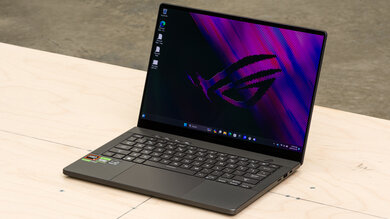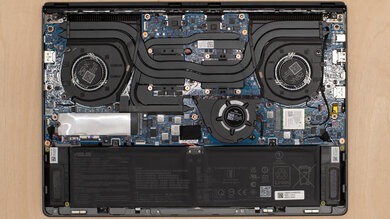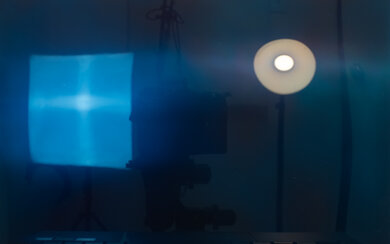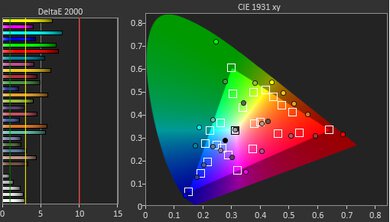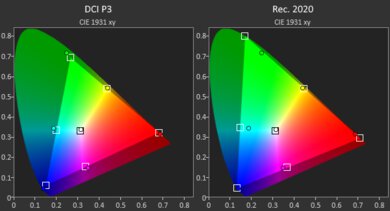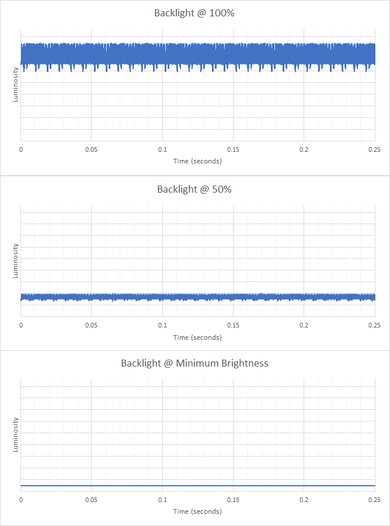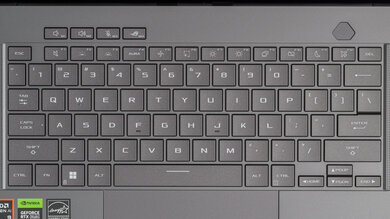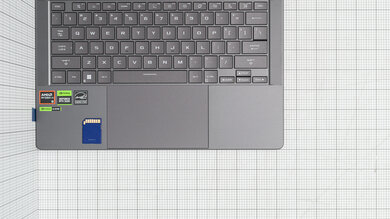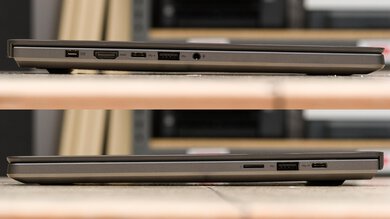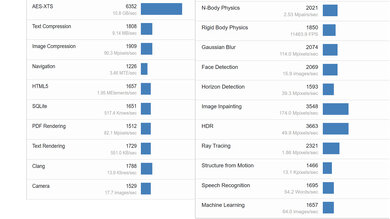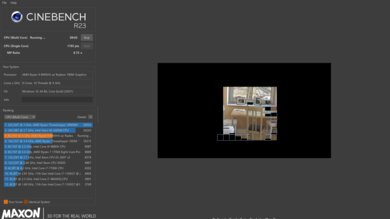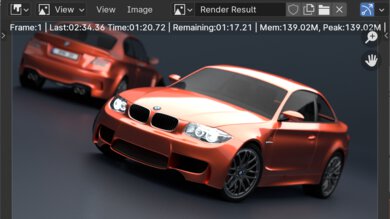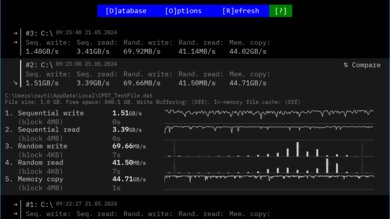The ASUS ROG Zephyrus G14 (2024) is a 14-inch gaming laptop. It replaces the ASUS ROG Zephyrus G14 from 2023 (model GA402). This 2024 (GA403) model is available with an AMD Ryzen 7 8845HS or Ryzen 9 8945HS CPU paired with an NVIDIA GeForce RTX 4050, RTX 4060, or RTX 4070 Laptop GPU. All three GPUs run at a TGP (Total Graphics Power) of 90W with Dynamic Boost. Memory and storage max out at 32GB and 1TB, respectively. It has a 120Hz 2.8K OLED display with G-SYNC support, Wi-Fi 6E wireless connectivity, a 1080p webcam, and a 73Wh battery. Ports comprise two USB-As, two USB-Cs (one with USB4 support), an HDMI 2.1, a MicroSD card reader, and a 3.5mm headphone jack.
See our unit's specifications and the available configuration options in the Differences Between Variants section.
Our Verdict
The ASUS ROG Zephyrus G14 (2024) is great for school use. It has a sturdy build, and its compact design makes it easy to carry around. It also provides a great user experience with its sharp OLED display, tactile keyboard, and large, responsive touchpad. Available with AMD CPUs and NVIDIA discrete GPUs, it has more than enough processing power to handle general productivity tasks and more demanding workloads, like programming and 3D modeling. Plus, the fans are relatively quiet, so you don't have to worry about causing too much noise in a classroom or library. The battery lasts around eight hours of light use, so depending on your workload, you may need to plug it in for a quick charge to get through the day.
- Compact design.
- Sharp, colorful OLED display.
- CPU and GPU can handle demanding workloads.
- Comfortable keyboard, responsive touchpad.
- Wide port selection.
- Battery might not get you through a typical 8-hour day, depending on use.
- OLED is susceptible to permanent burn-in.
The ASUS ROG Zephyrus G14 (2024) is a great gaming laptop. It's available with AMD Ryzen CPUs and NVIDIA 40-series GPUs, which are fast enough to provide a smooth gaming experience at 1080p or 1440p. With its 120Hz refresh rate, fast response time, and G-SYNC support, the OLED display delivers a clear image in fast-moving scenes with minimal ghosting or tearing. You can only get up to 1TB of storage, which isn't a lot considering the size of modern games, but thankfully, the SSD is user-replaceable. Thermal throttling is minimal, and the laptop doesn't get overly hot or loud under load.
- Delivers smooth gameplay in demanding games.
- 120Hz refresh rate with a faster response time and G-SYNC support.
- Wide port selection.
- Doesn't get overly hot or loud under load.
- Fast, replaceable SSD.
The ASUS ROG Zephyrus G14 (2024) is great for media consumption. It's very portable, thanks to its compact design, and its battery lasts around seven hours of video playback, giving you plenty of time to get through multiple movies and TV show episodes. Its OLED display looks sharp, bright, and colorful, and it produces deep, inky blacks for a fantastic dark room viewing experience. The speakers get pretty loud with minimal compression or distortion, and they sound full and well-balanced, with a good amount of bass.
- Compact design.
- Battery lasts around seven hours of video playback.
- Sharp, colorful OLED display.
- Loud speakers sound full, with a good amount of bass.
- OLED is susceptible to permanent burn-in.
- No touch input.
The ASUS ROG Zephyrus G14 (2024) is outstanding for use as a workstation. Its AMD Ryzen CPU and NVIDIA discrete GPU have enough processing power to handle demanding tasks like video editing, programming, and 3D animation. You can also perform color-correction tasks, as it has a 2.8k OLED display with full DCI P3 coverage. The keyboard feels comfortable to type on for an extended period, and there are plenty of ports for peripherals and external displays, including a USB-C with USB4 support and an HDMI 2.1 port. It doesn't get hot or loud under load, and thermal throttling is minimal. Unfortunately, you can only get up to 32GB of soldered RAM, which might not be enough for some workloads.
- CPU and GPU can handle demanding workloads.
- OLED display has full DCI P3 coverage.
- Wide port selection.
- Doesn't get overly hot or loud under load.
- Fast, replaceable SSD.
- Can only get up to 32GB of soldered RAM.
- OLED is susceptible to permanent burn-in.
The ASUS ROG Zephyrus G14 (2024) is great for business use. This 14-inch model feels incredibly well-built and is easy to carry around, making it a great option for those who travel a lot. It has a sharp OLED display, a spacious, tactile keyboard, and a large, responsive touchpad. Its AMD CPU and NVIDIA discrete GPU can easily handle general productivity tasks like text processing, web browsing, spreadsheets, and presentations. There's even enough processing power for photo or video editing, which is great for small business owners needing to do a little of everything. The battery lasts around eight hours of light use, so depending on your workload, you may need to plug it in for a quick charge to get through the day.
- Compact design.
- Sharp, colorful OLED display.
- Comfortable keyboard, responsive touchpad.
- Good 1080p webcam.
- Wide port selection.
- Battery might not get you through a typical 8-hour day, depending on use.
- OLED is susceptible to permanent burn-in.
Changelog
-
Updated Dec 05, 2025:
Added mention of the ASUS ROG Flow Z13 (2025) GZ302 as a 2-in-1 tablet alternative in the Style section.
- Updated May 07, 2025: We've updated this review to Test Bench 0.8.3, which removes the viewing angle tests and adds a GPU Total Graphics Power comparison in the GPU section. The Pen Input test in the Extra Features section has also changed, as it now shows whether the laptop supports pen input rather than the inclusion of a stylus in the box. See the changelog for more details.
- Updated Sep 26, 2024: Added mention of the ASUS ROG Strix G16 (2024) as an alternative with more powerful GPU options in the GPU section.
- Updated Jul 04, 2024: Added mention of the ASUS ROG Zephyrus G16 (2024) GU605 as an alternative with a larger, more immersive screen in the Screen Specs section.
Differences Between Sizes And Variants
We tested the ASUS ROG Zephyrus G14 2024 (model GA403U) with an AMD Ryzen 9 8945HS CPU, an NVIDIA GeForce RTX 4070 Laptop GPU, 16GB of memory, and 1TB of storage. The GPU, memory, and storage are configurable; the available options are in the table below.
| Screen |
|
|---|---|
| CPU |
|
| GPU |
|
| Memory |
|
| Storage |
|
| Color |
|
See our unit's label here.
Popular Laptop Comparisons
The ASUS ROG Zephyrus G14 (2024) is among the best laptops in its class. It stands out for its sturdy build, compact design, and the quality of its keyboard and touchpad. While its thermal design limits the GPU performance, capping the TGP at 90W, this laptop can still deliver a smooth gaming experience and provide enough processing power to handle demanding workloads like video editing and 3D modeling, making it a great option if you don't mind trading a bit of performance for portability.
See our recommendations for the best gaming laptops, the best Windows laptops, and the best laptops for video editing.
The Razer Blade 14 (2022) and the ASUS ROG Zephyrus G14 (2024) are both high-end gaming laptops that provide a similar user experience overall. It's worth noting that the Razer's speakers are significantly worse, producing a tinny, unnatural sound compared to the ASUS' full, well-balanced speaker system. Gaming performance depends on the configuration (for example, the Razer's RTX 3080Ti will still outperform the ASUS' RTX 4050). The main difference is that the newer 40-series GPUs support Frame Generation, a feature that boosts performance by inserting A.I.-generated frames. As for the display, the ASUS' OLED panel is arguably better, as it can produce deeper blacks for a better dark room viewing experience and get brighter to combat glare; however, it's limited to a 120Hz refresh rate, whereas the Razer is available with a 144Hz or 165Hz screen. Also, the ASUS' OLED display flickers, which might bother people who are sensitive to flickering.
The ASUS ROG Zephyrus G14 (2024) and the HP OMEN Transcend 14 (2024) are direct competitors in the high-end 14-inch gaming laptop market. They trade blows when it comes to the overall user experience; the G14's display has better reflection handling and G-SYNC support, while the OMEN has lower thermals and fan noise. As for GPU performance, although both laptops are available with the same GPUs, the G14's are faster, as they run at a slightly higher wattage.
The ASUS ROG Flow X13 (2023) and the ASUS ROG Zephyrus G14 (2024) are both great gaming laptops available with AMD Ryzen CPUs and NVIDIA discrete GPUs (up to an RTX 4070). The main difference is that the Flow X13 has a proprietary port that lets you connect ASUS' eGPU module and access desktop-level GPU power (up to an RTX 4090), albeit at a very steep price. For the most part, the G14 is a better option if you don't plan on using an external GPU, as its built-in discrete GPUs run at a higher wattage, allowing for better performance.
The ASUS ROG Zephyrus G14 (2024) and the Dell Alienware m16 R2 (2024) are both great gaming laptops available with NVIDIA 40-series GPUs (up to RTX 4070). The ASUS is a more compact model, making it a better option for on-the-go use; however, the Dell provides a better gaming experience, as its CPU and GPU can push higher, more consistent frame rates. As for the display, while the ASUS' OLED panel is arguably better in terms of sharpness and contrast, it's limited to a 120Hz refresh rate, whereas the Dell laptop's display has a 240Hz refresh rate, which will give you smoother motion and better input responsiveness.
Test Results

The ASUS ROG Zephyrus G14 (2024) is available in Platinum White or Eclipse Gray. See the bottom of the laptop. Check out the ASUS ROG Flow Z13 (2025) GZ302 if you prefer a 2-in-1 tablet PC form factor.
The ASUS ROG Zephyrus G14 (2024)'s build quality is outstanding. Its aluminum chassis feels very sturdy, exhibiting little to no flex on the lid or keyboard deck. The display doesn't twist when manipulating it. The finish is fairly scratch-resistant and doesn't pick up too many fingerprints or smudges. There are no complaints about the feet; they feel solid and stick firmly to the bottom.
Accessing the internals is relatively straightforward; you need to remove quite a few screws—11 total—and two of them are beneath the feet, so you have to remove the feet, too. Thankfully, you can easily remove the feet and put them back on because they aren't glued on. Once you remove the screws, the bottom panel pops off easily without the need for a prying tool. The SSD slot supports M.2 2280 PCIe Gen 4 NVMe SSDs.
Get the service and maintenance guide here.
The ASUS ROG Zephyrus G14 (2024)'s OLED display looks very sharp, with a pixel density exceeding that of the Apple MacBook Air 13 (2024)'s Retina display. Its 16:10 aspect ratio is quickly becoming the norm, even for gaming laptops. This format is great for productivity, as it gives you slightly more vertical space than a standard 16:9 screen, allowing you to see more information at once when reading a document or website. OLED panels are susceptible to permanent burn-in, especially with static elements like Windows' taskbar; however, it's unlikely to be an issue for those viewing varied content. Check out the ASUS ROG Zephyrus G16 (2024) GU605 if you want a laptop with a bigger screen for a more immersive gaming experience.
The display has a good response time, resulting in only a small amount of ghosting behind fast-moving objects. As for its refresh rate, although 120Hz feels reasonably responsive (certainly better than 60Hz), it's a slight downgrade from the 2023 ASUS ROG Zephyrus G14 (GA402), which has a 165Hz (Mini LED) display.
The display gets bright enough for use in most indoor settings but not outdoors in broad daylight. It's very dim at the lowest brightness setting, which is great for dark room viewing because it causes less eye strain.
The display's glossy finish handles reflections remarkably well. Reflections are only problematic when viewing dark-color content. Bright reflections, like a lamp, are visible when viewing light-color content with the screen at max brightness, but they aren't distracting.
The display's accuracy is good out of the box. The white balance inaccuracies are minor and hard to spot; however, many colors are visibly off due to oversaturation. Some people may like this punchy, oversaturated look; just know it isn't accurate. The gamma follows the curve relatively well, except in dark scenes where it's too high, resulting in crushed blacks.
The display's color gamut is superb. It has full coverage of the sRGB and DCI P3 color spaces and near-full coverage of the Adobe RGB color space, making it suitable for a wide range of uses, including media consumption, professional photo editing, and HDR video production.
The ASUS ROG Zephyrus G14 (2024) has an excellent keyboard. Its layout feels spacious and is easy to get used to. The keys have a good amount of travel, require little force to actuate, and provide clear tactile feedback. They aren't the most stable keys, as they wobble a bit, but it isn't bad enough to be of concern. This keyboard has RGB backlighting, but there's only one lighting zone.
The touchpad is excellent. It's quite large, and its surface feels very smooth, allowing fingers to slide easily across it. Tracking is excellent, except around the edges, where it feels a tad less responsive. Palm rejection works as intended, and there are no issues performing gestures like dragging and dropping. You can only click in the bottom half of the touchpad; the buttons feel satisfyingly tactile.
The ASUS ROG Zephyrus G14 (2024)'s speakers get pretty loud with minimal compression artifacts at high volume levels. They sound clear and full, with a good amount of bass.
The ASUS ROG Zephyrus G14 (2024) has a good webcam. The image looks detailed but slightly overexposed. As for the microphone, although voices come across clearly, there's a noticeable background hiss.
The ASUS ROG Zephyrus G14 (2024) has a good port selection. Both USB-As support USB 3.2 Gen 2 data transfer speed of up to 10Gbps. The USB-Cs have different specifications; the one on the left supports USB4 (up to 40Gbps data transfer speed), while the right one supports USB 3.2 Gen 2. Although both USB-Cs support DisplayPort, only the left one supports charging, and only up to 100W, so the battery will discharge if you use the laptop for intensive tasks while charging.
The wireless adapter is a MediaTek Wi-Fi 6E MT7922 (RZ616). Wi-Fi 6E gives you access to the 6GHz band, providing faster speeds, lower latency, and less signal interference than previous wireless standards; however, you need a router that supports Wi-Fi 6E to benefit from these features.
The ASUS ROG Zephyrus G14 (2024) is available with the following CPUs:
- AMD Ryzen 7 8845HS (8 cores/16 threads, up to 5.1GHz, 24MB cache)
- AMD Ryzen 9 8945HS (8 cores/16 threads, up to 5.2GHz, 24MB cache)
Both are 35W high-performance processors typically found in compact gaming and workstation laptops. They're essentially a refresh of the AMD Ryzen 7 7840HS and Ryzen 9 7940HS from the previous generation but with better NPU (Neural Processing Unit) performance to speed up A.I.-based tasks, like image generation in photo editing apps and background blurring during video calls. They can handle general productivity tasks as well as more demanding workloads like gaming, programming, and content creation. Core count and composition are the same for both CPUs; the only difference is that the Ryzen 9 8945HS has slightly faster lock speeds, typically resulting in only a small performance increase.
The ASUS ROG Zephyrus G14 (2024) is available with the following discrete GPUs:
- NVIDIA GeForce RTX 4050 Laptop GPU 6GB GDDR6 (90W TGP /w Dynamic Boost)
- NVIDIA GeForce RTX 4060 Laptop GPU 8GB GDDR6 (90W TGP /w Dynamic Boost)
- NVIDIA GeForce RTX 4070 Laptop GPU 8GB GDDR6 (90W TGP /w Dynamic Boost)
The available GPUs range from entry-level (RTX 4050) to the mid-range RTX 4070. They all support the same features, like DLSS, ray tracing, Frame Generation, and NVIDIA Reflex, so you aren't losing out on features if you go with the lower-end configurations. All three run at a TGP (Total Graphics Power) of 90W, which is somewhere in the middle of the recommended 35-115W power spectrum, so they aren't the weakest variants of these GPUs, but there's room for improvement.
If you want to play all of your games at the display's native 2.8k resolution, getting a model with an RTX 4070 is best. The RTX 4060 can handle games at that resolution; however, you'll have to play with most of the settings at or near minimum and rely on DLSS and Frame Generation to get playable frame rates. You'll have to lower the settings on models with an RTX 4070, too, just not as much. As for the RTX 4050, it's mainly for 1080p gaming. Again, you might be able to play at the 2.8k resolution in lighter games, like 2D platformers and older or highly optimized titles, but only with some tweaks in the graphical settings. If you want more powerful GPU options, consider the ASUS ROG Strix G16 (2024).
You can configure this laptop with 16GB or 32GB of RAM, though the 32GB option is only available on models with an NVIDIA GeForce RTX 4070 GPU. The memory isn't user-replaceable.
You can configure this laptop with 512GB or 1TB of storage. The SSD is user-replaceable; the slot supports M.2 2280 PCIe Geb 4 NVMe SSDs.
The AUS ROG Zephyrus G14 (2024)’s overall score in Geekbench 5 is outstanding. Its AMD Ryzen 9 8945HS CPU performs well in various workloads, beating the HP OMEN Transcend 14 (2024)'s Intel Core Ultra 9 185 CPU in single-thread performance (by roughly 13%) but losing in multi-thread (18% slower). The posted results are averages taken in the default Performance mode. Switching to the Manual mode with all settings maxed out doesn't impact the performance. The Ryzen 7 8845HS is only slightly slower, less than 5% difference in most workloads.
As for GPU computing tasks, the NVIDIA GeForce RTX 4070 Laptop GPU is very fast and can easily handle intensive workloads. The RTX 4050 and 4060 are suitable for heavy computing tasks, too; they're just slower, so you might experience more stutters in highly complex workloads and will have to wait longer for tasks to complete.
The AUS ROG Zephyrus G14 (2024)'s overall score in Cinebench R23 is outstanding. Its AMD Ryzen 9 8945HS CPU can easily handle intensive, multi-threaded workloads and general heavy multitasking. That said, there are significantly faster CPUs on the market, like the Dell Alienware m18 R2 (2024)'s Intel Core i9-14900HX and Apple's M3 Max SoC. Switching to the Manual performance mode with all settings maxed out only increases the performance by roughly 2%, boosting the multi-thread score to 15,895.
The ASUS ROG Zephyrus G14 (2024) is outstanding for Blender work. All three NVIDIA discrete GPU options can quickly render complex 3D images, so choosing between them depends on the complexity of your work and how fast you expect to complete tasks.
The ASUS ROG Zephyrus G14 (2024)'s RTX 4070 scores well in the Basemark GPU benchmark. As mentioned in the GPU section, the RTX 4060 and 4070 can handle demanding games at the QHD+ resolution; you just have to tweak the settings slightly more on the 4060 to get playable frame rates. The RTX 4050 is mainly for 1080p gaming, and even then, you might have to turn down some settings because it only has 6GB of VRAM.
Borderlands 3 runs relatively well at 1080p on the ASUS ROG Zephyrus G14 (2024) with an NVIDIA GeForce RTX 4070 Laptop GPU. The average frame rate is high; however, there are noticeable stutters due to frame drops. At the display's native 2.8k resolution, the average frame rate drops to 50 fps with high settings and 106 fps with low settings. The RTX 4050 GPU can likely push close to 60 fps at the 2.8k resolution, but only with the lowest graphical settings.
Every configuration can run Civilization VI and other similar games smoothly at 1080p or the display's native 2.8k resolution.
Every configuration of the ASUS ROG Zephyrus G14 (2024) can deliver smooth gameplay in Counter-Strike 2 and other similarly demanding games, even at the laptop display's 2.8k native resolution.
Every configuration of the ASUS Zephyrus G14 (2024) can run Shadow of the Tomb Raider smoothly at 1080p or the display's native 2.8k resolution. However, you'll have to lower the settings a bit and rely on DLSS to get high frame rates (at 2.8k resolution) on models with an RTX 4050 GPU.
The keyboard deck gets toasty under load, but the hot spot is at the top of the deck, so it's unlikely to be an issue in typical uses. Unfortunately, the bottom gets uncomfortably hotter, reaching a max temperature of 57.1 °C (134.78 °F).
The ASUS ROG Zephyrus G14 (2024) has a few pre-installed applications, including:
- ASUS Armory Crate: Lets you monitor the system status, change performance settings, create macros/hotkeys, customize the lighting (lid and keyboard), as well as access gaming news and the ASUS online shop.
- GlideX: Lets you mirror your screen's content to a smartphone, tablet, or computer.
- McAfee: Antivirus software. Requires subscription.
- MyASUS: Lets you connect your smartphone for file transfers, customer support, and power settings.
- Solitaire & Casual Games: Solitaire, FreeCell, Spider, Mahjong, Sudoku, and other casual games.
The ASUS ROG Zephyrus G14 (2024) has a Windows Hello facial recognition camera. You can use it to log into Windows, authorize purchases on the Windows Store, or auto-fill saved passwords on supported websites.

